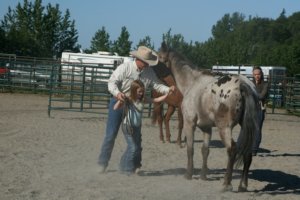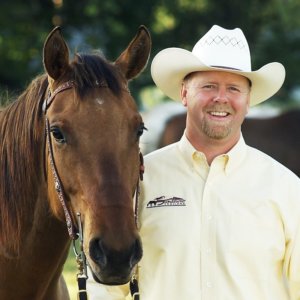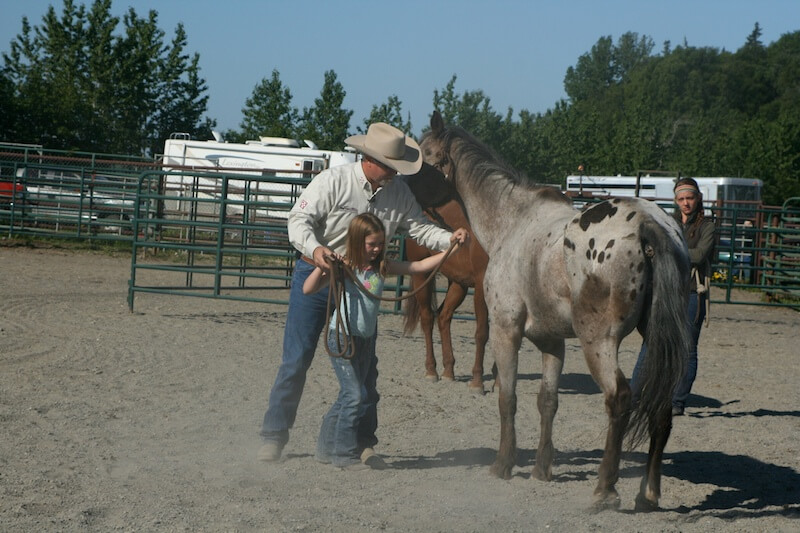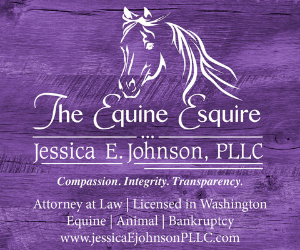To Win on the Trail, Prepare for the Worst
by Raye Lochert
There is a popular board game called “The Worst-Case Scenario.” The object of the game is to successfully navigate unexpected and dangerous scenarios. In one version, the winning player will not only finish with the most gold tokens, they must keep the most body parts. I think a useful game for equestrians might be called “Worst-Case Scenario—Trail Riding Edition.” Players would win by staying on the trail, gathering gold “sanity” tokens and, of course, keeping all their body parts!
Trail riding is the most popular thing to do with horses. More people are on the trail than all the competition events combined. Why? We love the relaxation of a scenic ride. As do LOTS of cyclists, hikers, dog walkers, and campers. With all these people sharing space there is bound to be some congestion, frustration, or worse. With a bit of forethought and preparation, you can be ready for the “worst-case scenario,” and maybe help keep someone else safe, too.

A sensitive flight animal, horses are usually aware of something well before it actually spooks them. This is usually when we ask them for their full attention and, by then, it is too late. You may be chatting with a friend or day dreaming when your horse reacts. By then it is too late to ask them to pay attention. To avoid the unpleasant, we must ride proactively using an ongoing, relaxed communication with our horse that keeps his focus on us. How do we accomplish this? With controlled riding.
An arena is a great place to practice the moves and cues you need your horse to understand when it counts. For me, that includes a horse that collects, turns left and right, stops and backs up with ease—the “basics.” If my horse will do these five things easily and with little pressure in the arena then I can prepare for the trail and the possibility of the worst case scenario.
How does one safely transition from the relative quiet of an arena to the unpredictability of the trail? By adding speed. With speed comes emotion—in both horse and rider. With this in mind, I practice my basic moves at speed. First I start with a walk, then a trot and then I practice at a lope. The faster I go the more the emotional level rises in the horse, lowering his performance. In the arena I can work on this and learn to control it more effectively. Let’s consider the stop. In the arena I work on my stops at the walk first. As soon as I increase the speed to the trot the level of performance in the stop goes down. Now I can return to the walk and work my way up to the trot again. Soon the horse will stop at the trot as well as they do at the walk, if not better. Once I can stop my horse 100% of the time at the trot softly and using the hindquarters I increase my speed to a lope. I do not expect the horse to stop as well at the lope as when they were trotting.
When I can do the basics with ease in the arena, I move outdoors. This is an area such as a pasture or even a quiet dirt road. Just being in a different place is enough to raise a horse’s emotions. When I have control in this outside environment I move to the park. When riding my horse in the park, I ask for the basics whenever I feel the horse’s attention is wandering. For example, let’s say my horse notices a mountain biker. When his attention diverts from me I ask him to collect up. This will get him to lower his head. As the bicyclist approaches, I will ask him to move his shoulders to the right or left. While we pass I talk to the bicyclist and keep asking my horse for a response to some cue. If I can keep my horse focused on listening to me by purposely distracting him he has less time to pay attention to the object of his fear.
After a while your horse will become more accustomed to the distractions of the trail and your responses will grow with practice, adding a level of confidence that will be noticed by your horse. A win-win situation. By preparing for the worst you actually set yourself up for the best, all while preserving you and your horse’s sanity (not to mention your body parts!). Remember to enjoy your horse.

Raye Lochert is a graduate of the John Lyons Certification program. Using his education, plus his own methods and unique way of teaching, he has developed a humane and constantly evolving program focused on the safety and success of both horse and rider. Working with horses and people of all levels and disciplines in a safe, fun and comfortable environment, Raye Lochert offers a very effective method of communication with horses that enables people to overcome road blocks and increase their enjoyment of their horse. At Raye Lochert Horsemanship, Raye and Sharon Lochert work hard to create an environment where people feel challenged yet safe. “It is like attending the University of the Horse,” says longtime student C.S. Noel. Learn more at www.rlhorsemanship.com
Published May 2013 Issue
Practical Horsemanship – that’s Raye. In an industry that’s exploding with information and trainers, Raye takes the confusion out of horse training. By taking a problem and breaking it down into smaller, doable steps, his solutions create successes for all horse people. No matter the discipline, the age of the horse or the level of experience or expertise of the rider, success is the end result.
There are many fantastic trainers in this industry. Unfortunately, a lot of what is being taught can’t safely be used by the average horse person. Raye wants to relay information in a way that makes sense and feels safe to everyone. If the horse handler finds it confusing or complicated, the horse doesn’t stand a chance.
In the vast sea of horsemanship clinicians, Raye is considered one of the most accessible teachers with an approachable style that truly sets him apart. His intense desire to help people achieve clear and consistent communication with their horses creates a much higher level of learning with his clients. No problem is too small and no question is silly.
In addition to clinics and lessons at Critter Creek Ranch in Santa Rosa, California, Raye travels all over the Western United States (including Hawaii and Alaska) conducting clinics, private lessons and demonstrations. His teaching is also available on DVDs and in special television programming. For more information on Raye Lochert and his schedule, visit Raye Lochert Horsemanship on Facebook.






